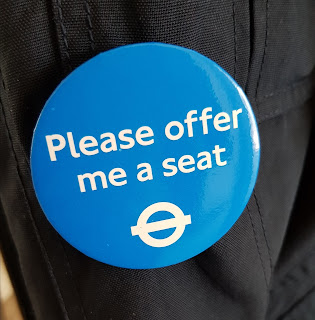Travelling on Public Transport with MS
Travelling on public transport with a chronic condition can be off-putting and soul-destroying for many reasons.
When you marry the words 'accessibility' and 'travel', many travel operators and media outlets automatically (and seemingly only) associate this with wheelchair access. However, for many passengers with non-visible conditions and disabilities, this isn't the case as we often have some, if reduced, mobility. Our mobility issues tend to centre around how far we can walk, how long we can stand and the fatigue associated with travel which knocks us for six.
What does this mean for a mobility-compromised traveller in practical terms?
1. You have to build in longer amounts of time to negotiate all of the inaccessible routes and paths within a station (never mind the other side of your journey). This article mentions time set aside as four times longer for a daily commute than for other commuters.
2. You have to pre-plan your journey to the 'nth degree, working out the best routes, sometimes using a number of different modes of transport to get from A to B.
3. If you've made your way to a tube platform when there are issues with the destination board, there is often no one on the platform to ask for support. You can of course press a button to speak to someone in an office, but you'll likely have to wait another length of time to speak face-to-face if it's difficult to communicate.
4. If you are bladder-challenged, to find a toilet on most trains is like finding an often very filthy, unhygienic needle in a long, moving haystack. Disabled toilets are often badly serviced in many stations. Smaller tube stations to do not have loos.
5. Sometimes, lifts at train/tube stations are poorly signposted and quite far from services (for someone who cannot walk very far), e.g. ticket machines, ticket barriers, platforms and so on. Sometimes, lifts give you access to the platform only. Rarely do they give you access from street level to the platform (unless you live in North or East London). Sometimes, they are out of order. One report suggests that 25% of the network is step free; another say about 40 of the 270 tube stations have step-free access.
The above is nowhere near an exhaustive list, but it is somewhat exhausting thinking about it all! As someone who works, I'd like to get to work safely and not feeling like I'd like to go home after a tricky journey.
In late 2016, TFL piloted the 'Please offer me a seat' badge on London's transport system. Just like the 'Baby on board' badge for pregnant passengers, this draws attention to those with invisible disabilities and conditions who are unable to stand, and need a seat.
It's drawn some criticism for its lack of regulation (as the application process doesn't validate a health condition) and also because, unlike some recent initiatives, TFL hasn't publicised this badge in the same extensive way as other initiatives, so there are many non-disabled passengers unaware of what it is there to do.
For those wheelchair-bound, it must be a very vulnerable experience to put your fate in the hands of others, and hope they have all of the facilities you need to complete your journey. There is a new app being developed by Transreport that will be an app version of passenger assist, giving disabled passengers a direct link to a train staff at their destination, however no details have been released as to a launch date.
'Please mind the gap between the train and the platform' has been a well used tube catchphrase. This gap is still visible in many stations of which some, if you are a wheelchair, scooter or stick user, you wouldn't dream of entering. 11% of Londoners, as per the London Travel Demand Survey, consider themselves disabled, though this 2012 TFL report mentions it could be anywhere up to 24%. The reports says that of these 11% of Londoners, 93% have reduced mobility, 2% using a wheelchair. According to the report, we are "travel shy." I've not had the word 'shy' applied to me in a number of years - "travel wary" or "travel fatigue" would feel more appropriate. It's not surprising that those with reduced mobility are not skipping out (excuse the analogy) of their homes and into London's transport system.
I haven't mentioned buses as most are accessible from a physical point of view (as long as someone nice lets you sit down) but how 'accessible' are they really for anyone when you're trying to get on public transport during rush hour, let alone someone with a condition?
The number of disabled users of the tube network should send a loud and clear message to those at TFL. There is indeed a gap, it seems, but sadly it's not just the one between the train and the platform.
If you have enjoyed reading my blog and would like to be notified of new posts and information from other organisations, please follow me at https://www.facebook.com/myMSbullyandme


